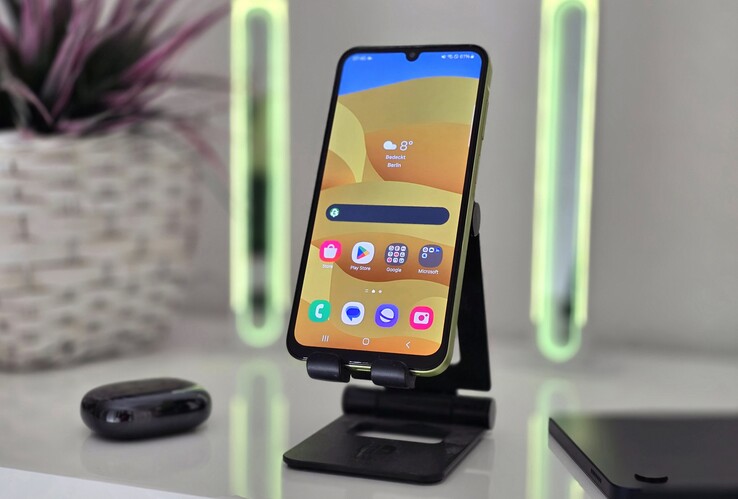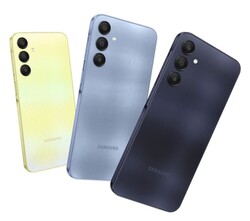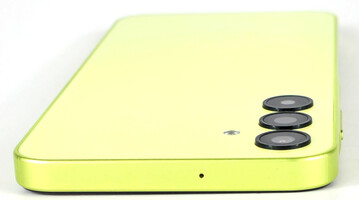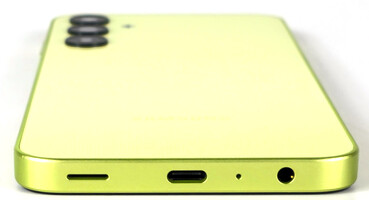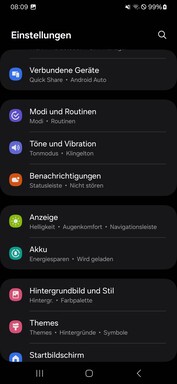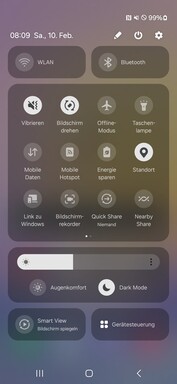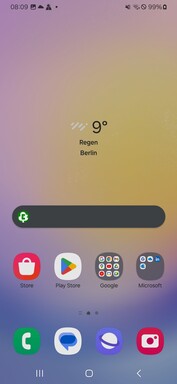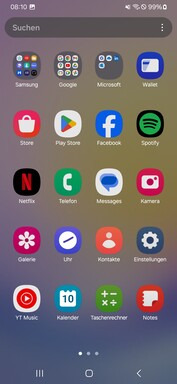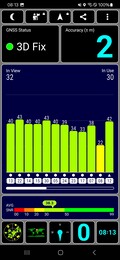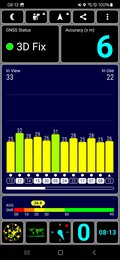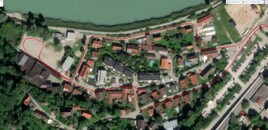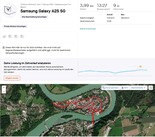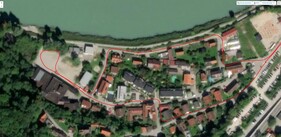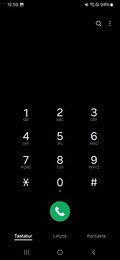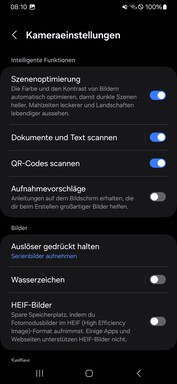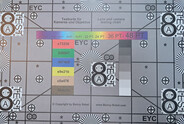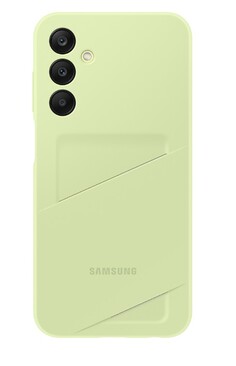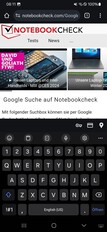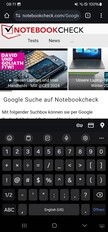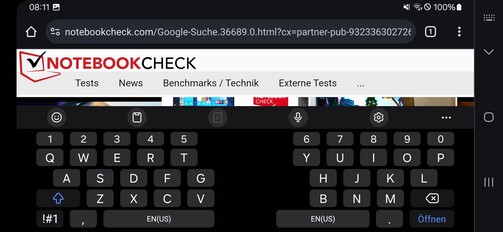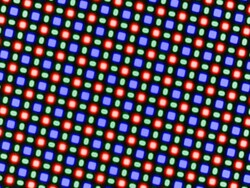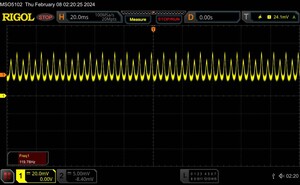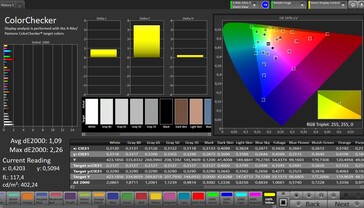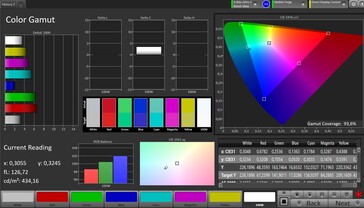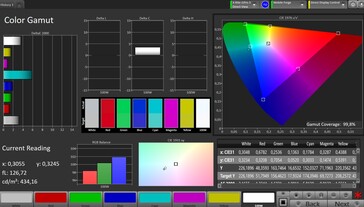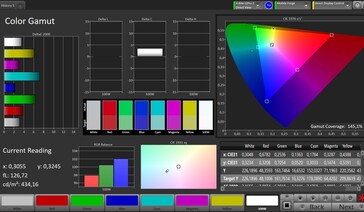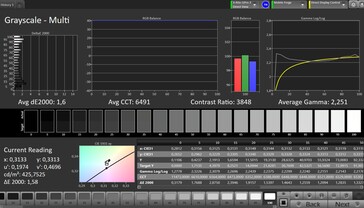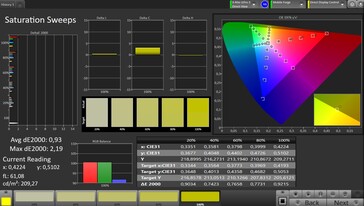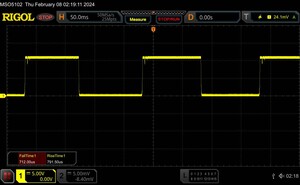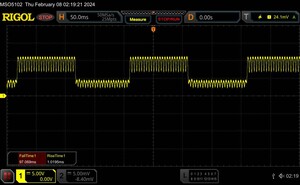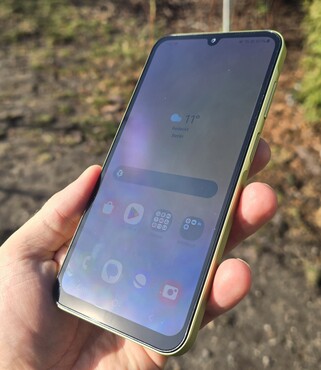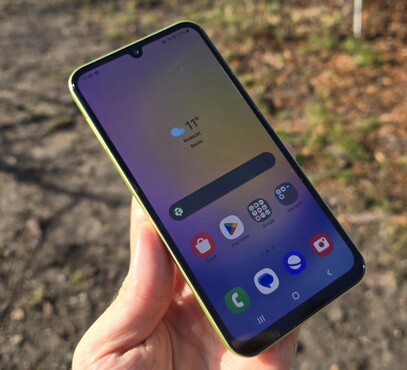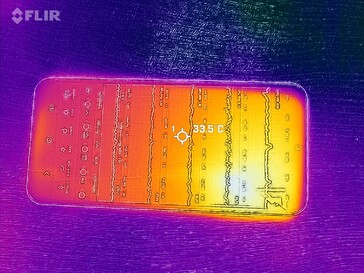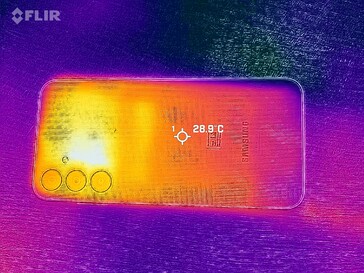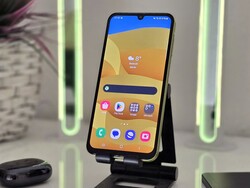Samsung Galaxy A25 5G smartphone review - Colorful, sustainable and really good! Is there a catch?
If you're on the hunt for a modern, and, above all, affordable 5G Samsung smartphone, look no further than the A25 5G - a suitable model in the Galaxy cosmos. To achieve this, the Korean manufacturer has equipped the device with the same 5G-capable Exynos 1280 that can be found in the Galaxy M34.
In addition to the guarantee of long updates, the 6.5-inch and lightning-fast, 120 Hz Super AMOLED display is certainly one of the Galaxy A25's highlights. On top of that, Samsung has fitted its budget mid-range smartphone with a rear camera that comes with optical image stabilization. Depending on the model variant, you can either have 6 GB of RAM and 128 GB of UFS mass storage or 8 GB of RAM and 256 of GB internal storage. However, up to now, the Samsung handset is only available in its basic configuration with an RRP of $299.
Possible competitors compared
Rating | Date | Model | Weight | Drive | Size | Resolution | Price |
|---|---|---|---|---|---|---|---|
| 84.5 % v7 (old) | 02 / 2024 | Samsung Galaxy A25 5G Exynos 1280, Mali-G68 MP4 | 197 g | 128 GB UFS 2.2 Flash | 6.50" | 2340x1080 | |
| 83.7 % v7 (old) | 02 / 2024 | Samsung Galaxy M34 5G Exynos 1280, Mali-G68 MP4 | 208 g | 128 GB UFS 2.2 Flash | 6.50" | 2340x1080 | |
| 82.2 % v7 (old) | 11 / 2023 | Motorola Moto G84 SD 695 5G, Adreno 619 | 166.8 g | 256 GB UFS 2.2 Flash | 6.50" | 2400x1080 | |
| 81.4 % v7 (old) | 06 / 2023 | OnePlus Nord CE 3 Lite 5G SD 695 5G, Adreno 619 | 195 g | 128 GB UFS 2.2 Flash | 6.72" | 2400x1080 | |
| 81.4 % v7 (old) | 05 / 2023 | Xiaomi Poco X5 SD 695 5G, Adreno 619 | 190 g | 128 GB UFS 2.2 Flash | 6.67" | 2400x1080 |
Case - The Samsung smartphone comes with a notch
The Samsung smartphone comes in the typical Galaxy A series design, including the display notch. But, compared to the Galaxy A34 5G, the Galaxy A25 has a wider "chin" below the display. This means, at 84.2 percent, the ratio between the AMOLED panel and the front side of the device is slightly less efficient – in this area, for example, the Poco X5 just has its nose in front with an 85 percent screen-to-body ratio. Samsung has not disclosed any information regarding the implemented protective glass.
The Galaxy A25 is available in three different color options "Blue Black", "Blue" and "Yellow" with every device possessing an eye-catching structure on the rear of the smartphone called "Haze Finish". However, the surface is very glossy and this leads to the presence of fingerprints. When it comes to how premium the device feels, there is also room for improvement considering the plastic rear is paired with a plastic frame. The Samsung smartphone lacks IP certification against spray water.
Weighing 197 grams, the Galaxy A25 is not a lightweight but you couldn't describe it as uncomfortably heavy either. The build quality is satisfactory and the gap dimensions are tight. The button's pressure points have a nice crisp feel.
Features - The Galaxy A25 5G has NFC
The affordable, mid-range smartphone's features include an NFC chip, stereo speakers, Bluetooth 5.3 as well as an audio jack for headphones. However, a mistake appears to have slipped into the data sheet since the installed Samsung SoC only supports the 5.2 standards. For wired data transfer, a USB type C connector stands at the ready and supports the slow USB 2.0 standard. Likewise on board is USB OTG which enables the quick connection of external accessories. The wireless transfer of display content to external monitors via Miracast is possible and, thanks to Widevine L1, video content from streaming services can be viewed in HD quality.
Our review sample comes with 128 GB of UFS 2.2 storage which has, in fact, a lower available capacity of 105 GB due to the operating system and some preinstalled apps. Despite this, the internal storage can be expanded via microSD cards.
microSD card reader
The Galaxy A25's integrated microSD slot covers all of the current standards including SDHC as well as SDXC up to 1 TB, however, memory expansion comes at the cost of losing the dual SIM capabilities.
When it comes to copy speed, at 27 MB/s, the Samsung smartphone runs solidly. The manufacturer's current entry-level tablet, the Tab A9, shows that more is feasible. In our tests, the Galaxy A23 copied images considerably quicker. In the Cross Platform Disk Test, the Galaxy A25 demonstrated itself to be very unstable. Nevertheless, paired with our AV PRO V60 reference card, the values are still convincing.
| SD Card Reader - average JPG Copy Test (av. of 3 runs) | |
| Motorola Moto G84 (Angelbird V60) | |
| Samsung Galaxy M34 5G (Angelbird V60) | |
| Samsung Galaxy A25 5G (Angelbird V60) | |
| Xiaomi Poco X5 (Angelbird AV Pro V60) | |
| OnePlus Nord CE 3 Lite 5G (Angelbird V60) | |
Cross Platform Disk Test (CPDT)
Software - The Samsung Galaxy A25 5G offers lengthy updates
One of the Galaxy A25's special features - especially in this price category - is its long-term software support. In this area of software maintenance, with four big Android updates and five years of security patches, Samsung is both exemplary and sustainable. No other $300 smartphone offers this.
In addition, the Galaxy phone already uses the current One UI 6 user interface that is based on Android 14. At the time of review, the Galaxy A25 is relying on the most recent security updates from Januar 2024. According to information provided by the manufacturer, the latter will be updated quarterly.
Communication and GNSS - The 5G Samsung smartphone
In home networks, the Galaxy A25 5G only transmits using WiFi 5, however, it includes support for VHT80 meaning that, in theory, a transfer speed of up to 800 MBit/s can be achieved. Although the Samsung handset has impressively consistent transfer rates, in no way does the Wi-Fi modem make the most of the maximum bandwidth. Just like the competition, paired with the Asus ROG Rapture GT-AXE11000, the Galaxy A25 reaches, on average, speeds of around 300 MBit/s.
For mobile internet access, the mid-tier phone supports access to the 5G network. With 17 LTE bands, the 4G frequency range is also very commendable for this price class. In German-speaking areas, users are very well covered but, we would recommend checking the necessary frequencies before embarking on a foreign trip.
| Networking | |
| Samsung Galaxy A25 5G | |
| iperf3 receive AXE11000 | |
| iperf3 transmit AXE11000 | |
| Samsung Galaxy M34 5G | |
| iperf3 receive AXE11000 | |
| iperf3 transmit AXE11000 | |
| Motorola Moto G84 | |
| iperf3 receive AXE11000 | |
| iperf3 transmit AXE11000 | |
| OnePlus Nord CE 3 Lite 5G | |
| iperf3 receive AXE11000 | |
| iperf3 transmit AXE11000 | |
| Xiaomi Poco X5 | |
| iperf3 receive AXE11000 | |
| iperf3 transmit AXE11000 | |
| Average of class Smartphone | |
| iperf3 receive AXE11000 | |
| iperf3 transmit AXE11000 | |
Positioning with the Galaxy A25 is done via single-band GNSS using the common satellite networks: Glonass, Galileo, BeiDou and GPS. Theoretically, the latter should be possible in dual-band, with the installed Exynos 1280 at least supporting this feature. In everyday use, the satellite fix happens swiftly and is also accurate inside buildings six meters tall.
On a bike tour, we took a closer at the Samsung smartphone's location quality, comparing it with the Garmin Menu 2. The total calculated distance only differed by 20 meters. However, in the detailed route analysis, minor inaccuracies could be observed in and after bends in the road. Despite this, overall, the Galaxy A25 manages to present a very accurate illustration of the travelled route.
Telephone functions and voice quality - The Galaxy A25 has dual SIM functionality
Held to your ear, the Galaxy A25's voice quality is pleasant sounding and voice reproduction is very natural. The mid-range smartphone can do both VoLTE and Wi-Fi calls as well as being able to house a fully functional dual SIM with two nano SIM card slots. However, the device is not eSIM-capable. Conveniently, the VoWiFi can be switched on and off via a button in the One UI quick menu.
Cameras - The Samsung phone comes with OIS
The Galaxy A25 possesses a 13 MPix selfie camera with a fixed focus. Under daylight conditions, the camera housed inside the display notch offers satisfactory sharpness and very decent exposure. The Samsung phone takes videos at a maximum of FullHD quality.
On the rear of the device, we have a 50 MPix camera with OIS and a bright f/1.8 aperture. Although Samsung has not disclosed which sensor it has installed, the key figures would suggest we are dealing with an in-house ISOCELL JN1 - the HW app device info is the same for the main camera. With a sensor size of 1/2.76 inches and a resolution of 50 MP, the 0.64-micrometer pixels are quite small but the ISOCELL 2.0 technology calculates 1.28-micrometer virtual pixels by default.
The main camera's color balance is kept quite neutral which means photos appear natural and not over-saturated. The Galaxy A25 is also no slouch when it comes to image sharpness, but, on closer inspection, a slight graininess is present, even in daylight. Exposure is not one of the 50 MPix lens's strengths. In return, we really like the low-light photos for a $300 cell phone. This is where the longer exposure time resulting from the OIS makes its presence felt.
The ultra wide-angle lens and its low-resolution 8 MP sensor are appropriate for this price category. Low dynamics and few image errors lead to solid image quality. Galaxy A25 users shouldn't expect print-standard images. The same applies to the 2 MPix sensor for macro shots which round off the rear triple-camera system.
The Samsung smartphone can record videos at a maximum of UHD resolution at 30 fps.
Image comparison
Choose a scene and navigate within the first image. One click changes the position on touchscreens. One click on the zoomed-in image opens the original in a new window. The first image shows the scaled photograph of the test device.
Main cameraMain cameraLow-lightWide-angleUnder controlled lighting conditions, we analysed the 50 MP lens's color reproduction compared to the actual reference colors. Typical for smartphones, photo brightening is visible, however, this only occurs very subtly. Otherwise, the Samsung camera software delivers surprisingly low deviations in the ColorChecker passport and hardly puts a foot wrong when it comes to color accuracy (>10).
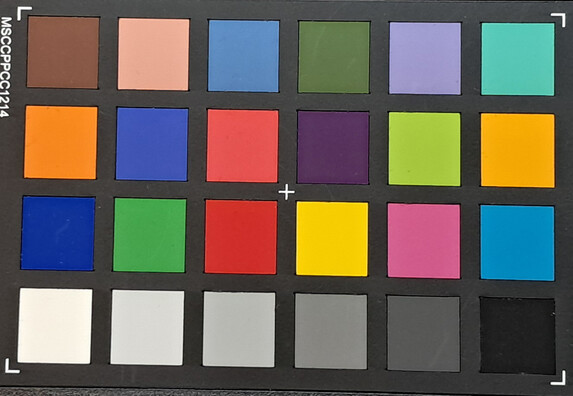
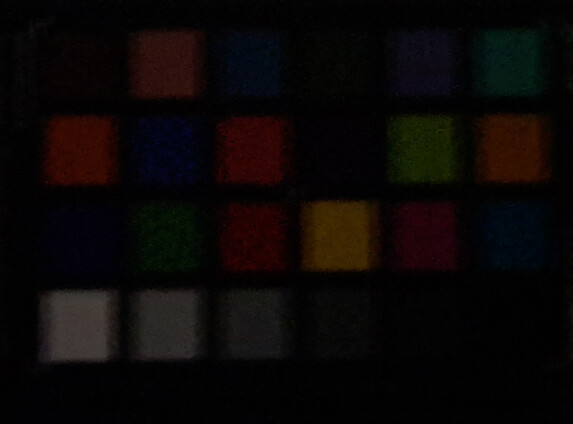
Accesories and warranty - The Samsung smartphone comes without a charger
Unfortunately, the Galaxy A25 5G doesn't come with a charger. In the box, you will only find a data/ charging cable (USB-C to USB-C), a SIM tool as well as a quick guide and the warranty conditions. Anyone who likes to use a case to protect their phone will find what they're looking for in the Samsung store.
In the US, Samsung offers a 12-month warranty on its cell phone. The manufacturer also offers the Care+ insurance package for the affordable mid-range device. Prices start at $8 per month for a 36-month term.
Input devices & operation - The Samsung Galaxy A25 5G has Face Unlock
The built-in AMOLED and its 120 Hz refresh rate are responsible for smooth animations and website scrolling. However, in everyday use, small stutters consistently rear their head in an otherwise smooth operating experience. Inputs on the 6.5-inch display are implemented quickly and accurately right into the corners of the touchscreen. Out-of-the-box, the manufacturer has opted against fitting the device with a screen protector.
A fingerprint scanner takes care of biometric security and is integrated into the power button. It's nicely positioned and easy to reach. The active sensor is sometimes somewhat slow to respond but still manages to deliver satisfactory recognition rates.
Using the front camera under good lighting conditions, the face recognition unlocking process works a little faster but is slightly less secure due to its use of 2D scanning technology.
Display - The Galaxy A25 OLED panel
The Galaxy A25's 6.5-inch Super AMOLED display has a resolution of 2,400 x 1,080 pixels, thereby achieving a pixel density of almost 400 ppi. The 120 Hz refresh rate doesn't adapt automatically depending on the use case but can only be switched manually between one of two levels - 60 or 120 Hz.
The South Korean manufacturer has specified the panel brightness to reach a maximum of 1,000 cd/m² (HBM) and is fairly in accordance with our measurements (1,088 cd/m²) when the ambient light sensor is active and an APL18 pattern is displayed on the screen. With a completely white image on the display, we measured a similar 946 cd/m². Having HDR10 and HGL support also makes the panel suitable for displaying HDR content.
Due to the type of display technology used here, the Galaxy A25 is not spared from screen flickering. In our measurements, the PWM frequency hardly fluctuates and sits at a relatively constant 120 Hz.
| |||||||||||||||||||||||||
Brightness Distribution: 96 %
Center on Battery: 912 cd/m²
Contrast: ∞:1 (Black: 0 cd/m²)
ΔE ColorChecker Calman: 1.09 | ∀{0.5-29.43 Ø4.81}
ΔE Greyscale Calman: 1.6 | ∀{0.09-98 Ø5.1}
145.1% sRGB (Calman 2D)
Gamma: 2.251
CCT: 6491 K
| Samsung Galaxy A25 5G Super AMOLED, 2340x1080, 6.5" | Samsung Galaxy M34 5G Super AMOLED, 2340x1080, 6.5" | Motorola Moto G84 P-OLED, 2400x1080, 6.5" | OnePlus Nord CE 3 Lite 5G IPS, 2400x1080, 6.7" | Xiaomi Poco X5 AMOLED, 2400x1080, 6.7" | |
|---|---|---|---|---|---|
| Screen | -13% | -20% | -132% | -48% | |
| Brightness middle (cd/m²) | 912 | 883 -3% | 894 -2% | 672 -26% | 674 -26% |
| Brightness (cd/m²) | 928 | 888 -4% | 889 -4% | 656 -29% | 683 -26% |
| Brightness Distribution (%) | 96 | 95 -1% | 94 -2% | 90 -6% | 98 2% |
| Black Level * (cd/m²) | 0.39 | ||||
| Colorchecker dE 2000 * | 1.09 | 1.76 -61% | 1.1 -1% | 3.88 -256% | 1.6 -47% |
| Colorchecker dE 2000 max. * | 2.26 | 2.51 -11% | 2.81 -24% | 7.89 -249% | 5.3 -135% |
| Greyscale dE 2000 * | 1.6 | 1.6 -0% | 3 -88% | 5.2 -225% | 2.5 -56% |
| Gamma | 2.251 98% | 2.109 104% | 2.252 98% | 2.218 99% | 2.21 100% |
| CCT | 6491 100% | 6626 98% | 7122 91% | 7734 84% | 6346 102% |
| Contrast (:1) | 1723 |
* ... smaller is better
Screen Flickering / PWM (Pulse-Width Modulation)
| Screen flickering / PWM detected | 119.8 Hz | ||
The display backlight flickers at 119.8 Hz (worst case, e.g., utilizing PWM) . The frequency of 119.8 Hz is very low, so the flickering may cause eyestrain and headaches after extended use. In comparison: 53 % of all tested devices do not use PWM to dim the display. If PWM was detected, an average of 8228 (minimum: 5 - maximum: 343500) Hz was measured. | |||
A series of measurements using a fixed level of zoom and various brightness settings
The mid-tier phone has a total of two color profiles. Using the "Vivid" profile it's possible to set the basic colors as well as the color temperature.
We analysed the AMOLED panel's color calibration using the Calman analysis software and a photo spectrometer. We achieved the best results using the "Natural" profile and observed very low color deviations as well as recording small differences in the displayed gray scale DeltaE values. It's also worth mentioning that in the comparison, the larger sRGB P3 color space was almost completely covered.
Display Response Times
| ↔ Response Time Black to White | ||
|---|---|---|
| 1.5 ms ... rise ↗ and fall ↘ combined | ↗ 7.1 ms rise | |
| ↘ 7.9 ms fall | ||
| The screen shows very fast response rates in our tests and should be very well suited for fast-paced gaming. In comparison, all tested devices range from 0.1 (minimum) to 240 (maximum) ms. » 7 % of all devices are better. This means that the measured response time is better than the average of all tested devices (20.4 ms). | ||
| ↔ Response Time 50% Grey to 80% Grey | ||
| 2 ms ... rise ↗ and fall ↘ combined | ↗ 1 ms rise | |
| ↘ 1 ms fall | ||
| The screen shows very fast response rates in our tests and should be very well suited for fast-paced gaming. In comparison, all tested devices range from 0.165 (minimum) to 636 (maximum) ms. » 8 % of all devices are better. This means that the measured response time is better than the average of all tested devices (31.8 ms). | ||
Performance - The Samsung smartphone has an Exynos SoC
The Galaxy A25 comes with the in-house manufactured, 5 nm process, Exynos 1280. The chipset possesses two Cortex A78 cores for power delivery and its graphics unit comes in the form of the integrated Mali G68 MP4.
In our series of benchmarks, the Samsung smartphone positions itself along with the Galaxy M34 5G, a little bit behind the Snapdragon 695 mid-range competition. However, in Geekbench, the Galaxy A25 performed marginally better than its sister model in the areas of both single-core and multi-core performance.
| CrossMark - Overall | |
| Average of class Smartphone (187 - 2674, n=131, last 2 years) | |
| Samsung Galaxy A25 5G | |
| Average Samsung Exynos 1280 (579 - 601, n=3) | |
| Xiaomi Poco X5 | |
| OnePlus Nord CE 3 Lite 5G | |
| UL Procyon AI Inference for Android - Overall Score NNAPI | |
| Average of class Smartphone (3769 - 81594, n=135, last 2 years) | |
| Xiaomi Poco X5 | |
| Motorola Moto G84 | |
| OnePlus Nord CE 3 Lite 5G | |
| Samsung Galaxy A25 5G | |
| Samsung Galaxy M34 5G | |
| Average Samsung Exynos 1280 (4126 - 5087, n=5) | |
| AImark - Score v3.x | |
| Average of class Smartphone (82 - 307528, n=124, last 2 years) | |
| OnePlus Nord CE 3 Lite 5G | |
| Motorola Moto G84 | |
| Samsung Galaxy A25 5G | |
In the graphics tests, with its Mali G68 MP4, the Galaxy A25 5G achieved very competitive results. With lower GFX Bench and 3DMark scores, the comparison devices and their Adreno 619 also fare worse here than the Samsung smartphone.
GFXBench (DX / GLBenchmark) 2.7: T-Rex Onscreen | 1920x1080 T-Rex Offscreen
GFXBench 3.0: on screen Manhattan Onscreen OGL | 1920x1080 1080p Manhattan Offscreen
GFXBench 3.1: on screen Manhattan ES 3.1 Onscreen | 1920x1080 Manhattan ES 3.1 Offscreen
GFXBench: on screen Car Chase Onscreen | 1920x1080 Car Chase Offscreen | on screen Aztec Ruins High Tier Onscreen | 2560x1440 Aztec Ruins High Tier Offscreen | on screen Aztec Ruins Normal Tier Onscreen | 1920x1080 Aztec Ruins Normal Tier Offscreen | 3840x2160 4K Aztec Ruins High Tier Offscreen
| 3DMark / Wild Life Extreme Unlimited | |
| Samsung Galaxy A25 5G | |
| Samsung Galaxy M34 5G | |
| OnePlus Nord CE 3 Lite 5G | |
| Motorola Moto G84 | |
| 3DMark / Wild Life Extreme | |
| Samsung Galaxy A25 5G | |
| Samsung Galaxy M34 5G | |
| Motorola Moto G84 | |
| OnePlus Nord CE 3 Lite 5G | |
| 3DMark / Wild Life Unlimited Score | |
| Samsung Galaxy A25 5G | |
| Samsung Galaxy M34 5G | |
| OnePlus Nord CE 3 Lite 5G | |
| Motorola Moto G84 | |
| 3DMark / Wild Life Score | |
| Samsung Galaxy A25 5G | |
| Samsung Galaxy M34 5G | |
| OnePlus Nord CE 3 Lite 5G | |
| Motorola Moto G84 | |
| 3DMark / Sling Shot Extreme (Vulkan) Unlimited Physics | |
| Motorola Moto G84 | |
| Samsung Galaxy M34 5G | |
| Samsung Galaxy A25 5G | |
| 3DMark / Sling Shot Extreme (Vulkan) Unlimited Graphics | |
| Samsung Galaxy A25 5G | |
| Samsung Galaxy M34 5G | |
| Motorola Moto G84 | |
| 3DMark / Sling Shot Extreme (Vulkan) Unlimited | |
| Samsung Galaxy M34 5G | |
| Samsung Galaxy A25 5G | |
| Motorola Moto G84 | |
| 3DMark / Sling Shot Extreme (ES 3.1) Unlimited Physics | |
| Motorola Moto G84 | |
| Xiaomi Poco X5 | |
| Samsung Galaxy M34 5G | |
| Samsung Galaxy A25 5G | |
| 3DMark / Sling Shot Extreme (ES 3.1) Unlimited Graphics | |
| Samsung Galaxy A25 5G | |
| Samsung Galaxy M34 5G | |
| Xiaomi Poco X5 | |
| Motorola Moto G84 | |
| 3DMark / Sling Shot Extreme (ES 3.1) Unlimited | |
| Samsung Galaxy M34 5G | |
| Samsung Galaxy A25 5G | |
| Motorola Moto G84 | |
| Xiaomi Poco X5 | |
| GFXBench (DX / GLBenchmark) 2.7 / T-Rex Onscreen | |
| Samsung Galaxy A25 5G | |
| Samsung Galaxy M34 5G | |
| Motorola Moto G84 | |
| Xiaomi Poco X5 | |
| OnePlus Nord CE 3 Lite 5G | |
| GFXBench (DX / GLBenchmark) 2.7 / T-Rex Offscreen | |
| Samsung Galaxy A25 5G | |
| OnePlus Nord CE 3 Lite 5G | |
| Samsung Galaxy M34 5G | |
| Xiaomi Poco X5 | |
| Motorola Moto G84 | |
| GFXBench 3.0 / Manhattan Onscreen OGL | |
| Samsung Galaxy M34 5G | |
| Samsung Galaxy A25 5G | |
| OnePlus Nord CE 3 Lite 5G | |
| Xiaomi Poco X5 | |
| Motorola Moto G84 | |
| GFXBench 3.0 / 1080p Manhattan Offscreen | |
| Samsung Galaxy A25 5G | |
| Samsung Galaxy M34 5G | |
| OnePlus Nord CE 3 Lite 5G | |
| Xiaomi Poco X5 | |
| Motorola Moto G84 | |
| GFXBench 3.1 / Manhattan ES 3.1 Onscreen | |
| Samsung Galaxy A25 5G | |
| Samsung Galaxy M34 5G | |
| OnePlus Nord CE 3 Lite 5G | |
| Xiaomi Poco X5 | |
| Motorola Moto G84 | |
| GFXBench 3.1 / Manhattan ES 3.1 Offscreen | |
| Samsung Galaxy M34 5G | |
| Samsung Galaxy A25 5G | |
| OnePlus Nord CE 3 Lite 5G | |
| Xiaomi Poco X5 | |
| Motorola Moto G84 | |
| GFXBench / Car Chase Onscreen | |
| Samsung Galaxy A25 5G | |
| Samsung Galaxy M34 5G | |
| Xiaomi Poco X5 | |
| OnePlus Nord CE 3 Lite 5G | |
| Motorola Moto G84 | |
| GFXBench / Car Chase Offscreen | |
| Samsung Galaxy M34 5G | |
| Samsung Galaxy A25 5G | |
| Xiaomi Poco X5 | |
| OnePlus Nord CE 3 Lite 5G | |
| Motorola Moto G84 | |
| GFXBench / Aztec Ruins High Tier Onscreen | |
| Samsung Galaxy M34 5G | |
| Samsung Galaxy A25 5G | |
| Xiaomi Poco X5 | |
| OnePlus Nord CE 3 Lite 5G | |
| Motorola Moto G84 | |
| GFXBench / Aztec Ruins High Tier Offscreen | |
| Samsung Galaxy M34 5G | |
| Samsung Galaxy A25 5G | |
| Xiaomi Poco X5 | |
| OnePlus Nord CE 3 Lite 5G | |
| Motorola Moto G84 | |
| GFXBench / Aztec Ruins Normal Tier Onscreen | |
| Samsung Galaxy M34 5G | |
| Samsung Galaxy A25 5G | |
| Xiaomi Poco X5 | |
| OnePlus Nord CE 3 Lite 5G | |
| Motorola Moto G84 | |
| GFXBench / Aztec Ruins Normal Tier Offscreen | |
| Samsung Galaxy A25 5G | |
| Samsung Galaxy M34 5G | |
| Xiaomi Poco X5 | |
| OnePlus Nord CE 3 Lite 5G | |
| Motorola Moto G84 | |
| GFXBench / 4K Aztec Ruins High Tier Offscreen | |
| Samsung Galaxy A25 5G | |
| Samsung Galaxy M34 5G | |
| Xiaomi Poco X5 | |
| OnePlus Nord CE 3 Lite 5G | |
| Motorola Moto G84 | |
When surfing with the Chrome browser, the Galaxy A25 impressed us with moderate loading times. The Samsung smartphone also did well in the benchmark test. In this area, the Samsung device is consistently ahead of its M34 5G sister model.
| Jetstream 2 - 2.0 Total Score | |
| Average of class Smartphone (13.8 - 387, n=148, last 2 years) | |
| Motorola Moto G84 (Chrome 118) | |
| Samsung Galaxy M34 5G (Chrome 120) | |
| Samsung Galaxy A25 5G (Chrome 122) | |
| Average Samsung Exynos 1280 (63.5 - 102.3, n=5) | |
| OnePlus Nord CE 3 Lite 5G (Chrome 114) | |
| Xiaomi Poco X5 (Chrome 113) | |
| Speedometer 2.0 - Result | |
| Average of class Smartphone (15.2 - 621, n=130, last 2 years) | |
| Samsung Galaxy A25 5G (Chrome 122) | |
| Samsung Galaxy M34 5G (Chrome 120) | |
| Motorola Moto G84 (Chrome 118) | |
| Average Samsung Exynos 1280 (48 - 90.6, n=5) | |
| OnePlus Nord CE 3 Lite 5G (Chome 114) | |
| Xiaomi Poco X5 (chrome 113) | |
| WebXPRT 4 - Overall | |
| Average of class Smartphone (27 - 302, n=143, last 2 years) | |
| Average Samsung Exynos 1280 (106 - 114, n=3) | |
| Samsung Galaxy A25 5G (Chrome 122) | |
| Motorola Moto G84 (Chrome 118) | |
| Samsung Galaxy M34 5G (Chrome 120) | |
| OnePlus Nord CE 3 Lite 5G (Chrome 114) | |
| Xiaomi Poco X5 (Chrome 113) | |
| WebXPRT 3 - Overall | |
| Samsung Galaxy A25 5G (Chrome 122) | |
| Average of class Smartphone (38 - 380, n=44, last 2 years) | |
| Motorola Moto G84 (Chrome 118) | |
| Average Samsung Exynos 1280 (69 - 187, n=4) | |
| OnePlus Nord CE 3 Lite 5G (Chrome 114) | |
| Octane V2 - Total Score | |
| Average of class Smartphone (2228 - 119218, n=196, last 2 years) | |
| Samsung Galaxy A25 5G (Chrome 122) | |
| Samsung Galaxy M34 5G (Chrome 120) | |
| Motorola Moto G84 (Chrome 118) | |
| Average Samsung Exynos 1280 (24159 - 32736, n=5) | |
| OnePlus Nord CE 3 Lite 5G (Chrome 114) | |
| Xiaomi Poco X5 (Chrome 113) | |
| Mozilla Kraken 1.1 - Total | |
| Xiaomi Poco X5 (Chrome 113) | |
| OnePlus Nord CE 3 Lite 5G (Chrome 114) | |
| Average Samsung Exynos 1280 (1244 - 1920, n=5) | |
| Motorola Moto G84 (Chrome 118) | |
| Samsung Galaxy M34 5G | |
| Samsung Galaxy A25 5G (Chrome 122) | |
| Average of class Smartphone (263 - 28190, n=151, last 2 years) | |
* ... smaller is better
When it comes to storage connectivity, the Galaxy A25's budget price makes itself known. The Samsung handset has only opted for the UFS 2.2 standard which is ok compared to the competition, however, in general, it can't be regarded as really fast. In addition, the Galaxy A25 delivers low read speeds for this type of storage – similar to the M34 5G. The reasons for this can no doubt be found in the Exynos SoC's installed memory controller.
| Samsung Galaxy A25 5G | Samsung Galaxy M34 5G | Average 128 GB UFS 2.2 Flash | Average of class Smartphone | |
|---|---|---|---|---|
| PCMark for Android | 1% | 70% | 374% | |
| Storage 2.0 seq. read int. (MB/s) | 439 ? | 471 ? 7% | 602 ? 37% | 1674 ? 281% |
| Storage 2.0 seq. write int. (MB/s) | 109.4 ? | 94.2 ? -14% | 451 ? 312% | 1532 ? 1300% |
| Storage 2.0 random read int. (MB/s) | 34.9 ? | 35 ? 0% | 29.3 ? -16% | 41.5 ? 19% |
| Storage 2.0 random write int. (MB/s) | 42.2 ? | 43.7 ? 4% | 44.5 ? 5% | 67 ? 59% |
| Storage 2.0 (Points) | 17052 ? | 18141 ? 6% | 18742 ? 10% | 52846 ? 210% |
Games - The Galaxy smartphone can hit 60fps
Despite being a mid-range smartphone, you can definitely grab a Galaxy A25 to play some PlayStore games. However, high frame-rate gaming is not possible with this budget device. Using the GameBench app, we took a look to see how smoothly Android games run.
At medium detail settings (HD mode), PUBG mobile ran at a constant 30fps, and, after reducing our test's graphics detail settings, the Galaxy A25 also only managed 30 frames per second. Our data bank shows that the graphics unit is generally capable of better performance. Both the 90fps setting as well as the UHD mode are not available.
The graphically demanding Genshin Impact is very playable at low graphics settings at an average of 37 fps and set to the highest details, many graphical errors and massive dips in the frame rate sneak into the fantasy action role-playing game.
Emissions - The Samsung Galaxy A25 5G hardly throttles
Temperature
In our load scenario, the case remained comparatively cool with an average of only 37 °C, however, the heat development builds up quite heterogeneously. The upper third of the Galaxy A25 has significantly higher temperatures than the "chin" area.
In terms of the Exynos SoC's performance, this hotspot didn't really make itself noticeable. With the 3DMark stress tests, we checked the performance under sustained load. For the Galaxy A25, we recorded scores of over 99 percent which attest to the system's consistent performance.
(-) The maximum temperature on the upper side is 45.4 °C / 114 F, compared to the average of 35.2 °C / 95 F, ranging from 21.9 to 247 °C for the class Smartphone.
(±) The bottom heats up to a maximum of 42.6 °C / 109 F, compared to the average of 33.9 °C / 93 F
(+) In idle usage, the average temperature for the upper side is 22.5 °C / 73 F, compared to the device average of 32.9 °C / 91 F.
3DMark Wild Life stress test
| 3DMark | |
| Wild Life Stress Test Stability | |
| OnePlus Nord CE 3 Lite 5G | |
| Motorola Moto G84 | |
| Samsung Galaxy M34 5G | |
| Samsung Galaxy A25 5G | |
| Wild Life Extreme Stress Test | |
| Samsung Galaxy A25 5G | |
| OnePlus Nord CE 3 Lite 5G | |
| Motorola Moto G84 | |
| Samsung Galaxy M34 5G | |
Speakers
The Galaxy A25 doesn't possess fully-featured stereo speakers but, with the second speaker placed in the ear cup, a slight stereo feeling is present and the audio quality - despite lacking bass - is quite decent for a mid-range smartphone. Nevertheless, at 80 dBA, it could be somewhat louder. When it comes to pink noise, you can hear an increase in the mids and a decrease in the highs, however, for this price category, the progression is still quite linear.
Wired headphones can be connected via the 3.5 mm audio jack. Alternatively, wireless transmission is possible with the help of Bluetooth. The only available audio codecs are SBC, AAC, aptX as well as LDAC and SSC.
Samsung Galaxy A25 5G audio analysis
(±) | speaker loudness is average but good (79.6 dB)
Bass 100 - 315 Hz
(-) | nearly no bass - on average 15.5% lower than median
(±) | linearity of bass is average (14.1% delta to prev. frequency)
Mids 400 - 2000 Hz
(±) | higher mids - on average 6.3% higher than median
(+) | mids are linear (4.3% delta to prev. frequency)
Highs 2 - 16 kHz
(+) | balanced highs - only 4.6% away from median
(+) | highs are linear (5% delta to prev. frequency)
Overall 100 - 16.000 Hz
(±) | linearity of overall sound is average (18.5% difference to median)
Compared to same class
» 19% of all tested devices in this class were better, 9% similar, 72% worse
» The best had a delta of 12%, average was 35%, worst was 134%
Compared to all devices tested
» 40% of all tested devices were better, 8% similar, 52% worse
» The best had a delta of 4%, average was 24%, worst was 134%
Xiaomi Poco X5 audio analysis
(+) | speakers can play relatively loud (93 dB)
Bass 100 - 315 Hz
(-) | nearly no bass - on average 26.2% lower than median
(+) | bass is linear (3.3% delta to prev. frequency)
Mids 400 - 2000 Hz
(±) | reduced mids - on average 5.8% lower than median
(+) | mids are linear (4.7% delta to prev. frequency)
Highs 2 - 16 kHz
(±) | higher highs - on average 5.2% higher than median
(+) | highs are linear (2.9% delta to prev. frequency)
Overall 100 - 16.000 Hz
(±) | linearity of overall sound is average (17.7% difference to median)
Compared to same class
» 13% of all tested devices in this class were better, 8% similar, 79% worse
» The best had a delta of 12%, average was 35%, worst was 134%
Compared to all devices tested
» 34% of all tested devices were better, 8% similar, 58% worse
» The best had a delta of 4%, average was 24%, worst was 134%
Battery life - The Samsung smartphone charges slowly
Power consumption
The 5,000 mAh battery can be charged at up to 25 watts but you will have to purchase a suitable charger separately. A full charge with an appropriately powerful power source takes around 1.5 hours – in our test, we used a powerbank (PD 3.0, max. 100-watt).
The Galaxy A25's power consumption under both load and when running idle is inconspicuous.
| Off / Standby | |
| Idle | |
| Load |
|
Key:
min: | |
| Samsung Galaxy A25 5G 5000 mAh | Samsung Galaxy M34 5G 6000 mAh | Motorola Moto G84 5000 mAh | OnePlus Nord CE 3 Lite 5G 5000 mAh | Xiaomi Poco X5 5000 mAh | Average Samsung Exynos 1280 | Average of class Smartphone | |
|---|---|---|---|---|---|---|---|
| Power Consumption | 4% | 19% | 6% | 17% | 3% | -13% | |
| Idle Minimum * (Watt) | 1 | 1 -0% | 1 -0% | 1.1 -10% | 0.96 4% | 0.996 ? -0% | 0.854 ? 15% |
| Idle Average * (Watt) | 1.5 | 1.2 20% | 1.3 13% | 1.5 -0% | 1.49 1% | 1.374 ? 8% | 1.423 ? 5% |
| Idle Maximum * (Watt) | 1.7 | 1.7 -0% | 1.4 18% | 1.7 -0% | 1.53 10% | 1.664 ? 2% | 1.592 ? 6% |
| Load Average * (Watt) | 4.6 | 4.5 2% | 3.5 24% | 4.1 11% | 3.52 23% | 4.54 ? 1% | 7.25 ? -58% |
| Load Maximum * (Watt) | 8.3 | 8.4 -1% | 5 40% | 5.8 30% | 4.32 48% | 7.78 ? 6% | 11.1 ? -34% |
* ... smaller is better
Power consumption: Geekbench (150 cd/m²)
Power consumption: GFXBench (150 cd/m²)
Battery runtime
The Samsung phone's runtimes are impressive but not on the same level as a Galaxy M34 5G - for our tests, we used the full, 120 Hz refresh rate.
The typical, greatly increased power consumption of the communication modules was very noticeable in the Galaxy A25 when running the Big Buck Bunny video endless loop. At around 15.5 hours, the Samsung smartphone only lasted just short of 3 hours longer in our Wi-Fi battery test with adaptive display brightness (150 cd/m²).
| Samsung Galaxy A25 5G 5000 mAh | Samsung Galaxy M34 5G 6000 mAh | Motorola Moto G84 5000 mAh | OnePlus Nord CE 3 Lite 5G 5000 mAh | Xiaomi Poco X5 5000 mAh | |
|---|---|---|---|---|---|
| Battery Runtime | 29% | 15% | 18% | -0% | |
| Reader / Idle (h) | 29.4 | 35.9 22% | 33.3 13% | 36.1 23% | 24.7 -16% |
| H.264 (h) | 15.7 | 20.1 28% | 16.7 6% | 17.2 10% | 14.9 -5% |
| WiFi v1.3 (h) | 12.8 | 17.7 38% | 15.1 18% | 16.4 28% | 11 -14% |
| Load (h) | 3.8 | 4.8 26% | 4.6 21% | 4.2 11% | 5.1 34% |
Pros
Cons
Verdict - Samsung Galaxy A25 5G
With its new Galaxy A25 5G, Samsung has done a lot right. The mid-range smartphone looks stylish and offers a well-rounded set of features which is complimented by long-term software support. Highlights, in addition to the software maintenance, are the bright and very well-calibrated (for its price class) AMOLED panel. But, we were also positively surprised by the 50 MPix OIS camera, especially in low-light situations. Anyone in the Galaxy cosmos not satisfied with the Galaxy A25's battery life could find a long-lasting alternative in the form of the Galaxy M34 5G. In addition, the sister model is IP67 certified, unlike the Galaxy A25.
The Samsung Galaxy A25 is a very good mid-range smartphone whose small stutters you will have to forgive.
The installed Exynos 1280 is a solid chipset, especially when considering the RRP of under $300. However, the Samsung SoC is not always capable of continually providing the Galaxy A25 with sufficient power to guarantee a stutter-free user experience. There's still some room for improvement in this area when it comes to driver and software optimization. The same applies to the long charging times and the limited choice of Bluetooth codecs. With its Nord CE 3 Lite, Oneplus demonstrates that more is possible regarding these points.
Anyone on the lookout for a somewhat slimmer and, above all, lighter device than the Galaxy A25, should take a closer look at the Motorola Moto G84.
Price and availability
With an RRP of $300, the Samsung Galaxy A25 5G smartphone is currently available on Amazon.
Samsung Galaxy A25 5G
- 02/12/2024 v7 (old)
Marcus Herbrich
Transparency
The selection of devices to be reviewed is made by our editorial team. The test sample was provided to the author as a loan by the manufacturer or retailer for the purpose of this review. The lender had no influence on this review, nor did the manufacturer receive a copy of this review before publication. There was no obligation to publish this review. We never accept compensation or payment in return for our reviews. As an independent media company, Notebookcheck is not subjected to the authority of manufacturers, retailers or publishers.
This is how Notebookcheck is testing
Every year, Notebookcheck independently reviews hundreds of laptops and smartphones using standardized procedures to ensure that all results are comparable. We have continuously developed our test methods for around 20 years and set industry standards in the process. In our test labs, high-quality measuring equipment is utilized by experienced technicians and editors. These tests involve a multi-stage validation process. Our complex rating system is based on hundreds of well-founded measurements and benchmarks, which maintains objectivity. Further information on our test methods can be found here.




